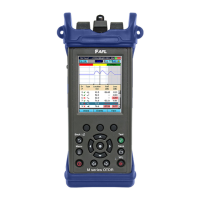70
FAQs
Can I save traces for viewing later?
Yes. There is a dedicated Save key. In the Main Menu “File tab”, set up the location/folder
(Internal or USB) to save the le, the le naming format, and ber number. The ber number will
automatically increment after each trace is saved.
What is the advantage of the Expert Auto mode?
User is able to select a single
and have the OTDR set the other test parameters.
What is the advantage of the Expert Auto Once mode?
User is able to select one or more wavelengths, let the OTDR select Pulse Width, Time, and Range
for one test. Then allow the user to adjust any of these test parameters for the next test(s).
What is the purpose of the Real-Time mode?
With a launch cable, the Real-Time mode may be used to quickly view many short ber links. It can
also be used to quickly “trace” short ber links.
Why do I need to use a launch and receive cable?
A launch cable allows the OTDR to settle down after the initial pulse and provides a reference
cable for testing the rst connector on the ber under test. A receive cable provides a reference
cable for testing the last connector of the ber under test.
Bi-directional Averaging
Q:
Why should I average OTDR results from both ends (bi-directional averaging)?
A: In networks built with a mix of ber types (older and newer ber, G.652 and G.655 or G.657
ber), an OTDR scan may show excess loss at a splice joining these bers when viewed in one
direction, and may show “gain” (negative loss) when viewed in the opposite direction. The actual
splice loss can be computed by averaging the excess loss in one direction with the gain in the
opposite direction. If the average loss meets the carrier’s splice acceptance criteria, there is no need
to re-splice the connection, even though the excess loss when viewed in one direction exceeds the
splice acceptance criteria. Bi-directional averaging automatically pairs traces taken from both ends,
averages them and presents the averaged results.
Q:
To perform bi-directional averaging, must both traces be obtained using the same OTDR?
A: Two different M310s may be used to acquire the results, but the results from both ends must
be available in one M310 for that M310 to perform bi-directional averaging. This is most easily
accomplished if the same M310 is used to test from both ends.
Q:
How should les be named so the M310 can automatically match results from both ends and
perform bi-directional averaging?
A: There is no special naming convention required for automatically matching results from both
ends. What is required is that the both tests are run, and results stored, in the same job\route\
cable\ le. It’s preferable to run, and save, tests from both ends in the same ber le, and use the
same OTDR, for better results organization. After running the test with the OTDR at one end (say

